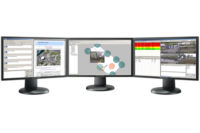Since the introduction of physical security information management (PSIM) systems several years ago, their greatest successes have been at the high end of the market. However, growing familiarity is promoting use of PSIM systems in a wider range of applications — and opening new opportunities for dealers and integrators.
Dean Novak, CEO of OSSI, a PSIM supplier based in Waukesha, Wis., says installing a PSIM does not require an integrator to install or even to maintain the variety of systems that provide information to the PSIM; the integrator only has to deal with the software links among them. “Implementing a PSIM is no more difficult than installing an enterprise access control system,” Novak describes. “We give you all the tools — everything is drag-and-drop.”
It’s inexpensive, too. In fact, using a PSIM in lieu of an enterprise access control system can expand capabilities and lower costs, Novak proposes. A key aspect of PSIMs is their ability to support current technology as well as to incorporate legacy systems, Novak says. He contends PSIM systems should be able to integrate directly to hardware sensors and not require a host-to-host application, i.e., a separate server for each application. OSSI’s Intelli-Site system, for example, integrates access control, CCTV and network video, fire, intrusion, perimeter detection and other systems into an easily managed end-user control system.
David Lassig, president of Professional Systems Technology, Salt Lake City, Utah, an OSSI integrator, says the Intelli-Site system allows him to simplify jobs and offer more functionality using fewer manufacturers. For example, the Intelli-Site PSIM can take the place of an enterprise access control system and manage video, fire alarm, intercoms, HVAC systems, etc. Fewer interface problems and easier installation expand the products Lassig can sell to each customer, thus maximizing the value of each job, he says.
Trickling Down the Pyramid
James Chong, founder and CTO of VidSys, Vienna, Va., sees the PSIM market as a pyramid, with high-end applications at the top of the pyramid including critical infrastructure, rails, airports, seaports, transportation, government, municipal and public safety. As PSIM technologies mature, the systems will be used increasingly in the middle of the pyramid, in industrial and high-tech companies, financial services, healthcare, and education (especially in universities). Chong says the maturing market is on the verge of “taking off,” currently at an inflection point before rapid growth begins.
From the beginning, the VidSys platform was developed as a browser-based solution and a Web-based platform. The approach, which predated today’s emphasis on cloud solutions, does not require specific client software to be installed as with client-server systems. “You just open a browser and you can access the full suite of functionality,” Chong describes. He says the next phase of PSIM development will include more mobile applications and 3-D visualization. The technology also will embrace more information systems (the IM in PSIM), monitoring IT events, and addressing vulnerability and risk assessments, for example.
Selling PSIM requires a different skill set than selling components, Chong advises. It is a more consultative, solutions sale, and being successful requires integrators to increase internal sales training as well as IT and software education.
As PSIMs become more common, new suppliers are entering the market, looking especially to expand mid-market applications. For example, Bold Technologies, Colorado Springs, Colo., offers a PSIM built around the company’s successful UL-listed Manitou platform familiar in the central station market. The enhanced Manitou PSIM offers a single point of control interface for a variety of systems, from access control to video to IT systems to phone and PBX systems, using user-defined maps and providing real-time incident data and live video feeds, all fully customizable. The system uses a “threat level” system, which adjusts action patterns and workflows being presented to an operator depending on a threat level, which might change when a high-profile guest visits, for example.
Rod Coles of Bold Technologies says the product is strong in retail and universities and excels at interfacing with outside products using the company’s Universal Connector. The system is targeting the middle market — manufacturing plants, as well as education and retail. Also evolving from the alarm market, DICE Corp. offers a cloud-based PSIM with a browser interface that serves mobile devices, whether an iPad, smartphone or mobile computer in a patrol car. The completely customizable cloud system can allow 200 log-ins from mobile devices.
“A PSIM is a very advanced alarm system that encompasses everything,” says Cliff Dice, owner and CEO of DICE Corp., based in Bay City, Mich. “We have basically said we are bringing all these other things into our UL-listed and FM-approved product.” The cloud-based system does not require dealers to sell PSIM-related hardware or equipment; there’s just a monthly fee to the customer that dealers could mark up to provide recurring revenue.
Integrators Need Additional Skills
Market education is paramount as more integrators enter the PSIM market, says Larry Lien, vice president, product management of San Jose, Calif.-based Proximex. The market provides an opportunity for an integrator to increase his value as a “trusted partner” to customers. Working with PSIM systems requires that the integrator understand more than ever about end-users’ security operations, business practices and compliance restrictions. That understanding makes integrators more valuable suppliers. “The integrator can establish more ‘stickiness’ with a customer, provide a more consultative approach — not just selling a commodity product, but providing business value,” Lien explains.
Proximex, acquired by ADT in March 2011, continues to operate as a separate entity under Tyco, and works with a variety of channel partners and integrators.
Proximex provides the Surveillint PSIM product to connect and correlate information from disparate systems and to consolidate information to mitigate risk. Incorporating an end-user’s protocols and standard operating procedures, the system’s “business logic” intelligent policy engine automates manual and time-consuming tasks for fast and accurate response.
“The ROI of deploying a PSIM solution and the savings it creates are significant, but not easily measured,” concedes Adlan Hussain, global head of marketing for CNL Software, headquartered in the U.K. “The cost of not deploying a PSIM solution, and the risks it exposes an organization to, are easier to understand.” PSIM also offers a means of leveraging additional value of existing equipment by more effectively managing and integrating legacy systems, Hussain says.
CNL Software’s IPSecurityCenter is a PSIM integration and management platform that connects and manages disparate building and security technologies. A Common Operating Picture (COP) provides situational awareness, guiding response step-by-step following an alert, alarm or event. The system’s scalability enables it to be used at some of the largest PSIM projects in the world, Hussain says.
PSIMs open opportunities for larger projects and larger clients, notes Frank Pervola, business development manager for transportation of Tyco Integrated Security’s Federal Systems Division, which handles a variety of airport, seaport and related transportation projects using the Proximex Surveillint system. PSIM technology can “take it to the next level with additional work for an integrator with an end user customer,” Pervola says. Installing PSIM platforms relates to a variety of systems throughout an organization — communications, emergency notification, paging, building management, elevators, etc. A PSIM-focused integrator is drawn into conversations about all those systems, which is an opportunity to expand business into new product categories, and heightens an integrator’s value overall, he says.
Mark Mills, president of Communication Concepts (a VidSys integrator), says becoming a trusted resource opens the door for additional business from an end-user customer. “You have a lot more leverage with the customer because you are at the head-end [providing a PSIM system], and everything has to be compliant,” he explains. “You will be the trusted resource; they will come back to you first.”
What’s in a Name?
Integrators might wonder: What constitutes a PSIM and what are the minimum attributes? The answers vary among various sources and from one supplier to another. Here is a sampling:
Dean Novak of OSSI says a PSIM should include six components: collection, analysis, verification, resolution, reporting and audit trail.
CNL Software lists these essential elements of a PSIM: open platform, data collection, data aggregation, geospatial engine, incident resolution, reporting and modular platform.
IMS Research defines a PSIM as including real-time policy/configuration management, correlation and verification, visualization, rules-based workflow for response, availability/resilience and post-event reporting and analysis. The full IMS description is available here (http://imsresearch.com/news-events/press-template.php?pr_id=1779).
James Chong of VidSys defines a PSIM as “software that converts data that is meaningless into information that is meaningful and actionable.” The simple definition describes the use of intelligent software that uses rules to filter the type, location, duration and frequency of events and data. Chong warns that PSIM is often used as a buzzword to describe systems that are not actual PSIMs. He says integrators should beware of phrases such as “PSIM light,” “PSIM-like” and “video-centric PSIM.”
“The definition confusion is one part of the education process we have to overcome,” Chong says.
The Role of Standards
Two organizations, Open Network Video Interface Forum (ONVIF) and Physical Security Interoperability Alliance (PSIA), are working to develop global standards, useful in the PSIM environment, for the interface of IP-based physical security products.
ONVIF emphasizes standardization of communication and interoperability between IP-based products regardless of manufacturer. Familiar in the video arena, ONVIF specifications define a common protocol for the exchange of information between network video devices including automatic device discovery, video streaming and intelligence metadata.
The Physical Security Interoperability Alliance is working towards plug-and-play interoperability for IP-enabled security devices. Currently PSIA has four functional specifications — video, recording/content management (storage), analytics, and area control (access control and intrusion).
“Companies had to invest a lot of money to write interfaces to a variety of devices,” says Dave Bunzel, executive director of PSIA. “We are making their lives easier by reducing the number of APIs (application programming interfaces) they have to write.”
At ASIS in Philadelphia, PSIA demonstrated plug-and-play integration between PSIM systems (specifically Proximex and NICE Systems) and various access control systems, intrusion detection devices and sensors, cameras and video storage and retrieval systems.
MORE ONLINE
Check out SDM’s webinar, free on demand: Why Education Security Graduated to PSIM Technology —http://www.sdmmag.com/events/876
For further reading, see:
“Using PSIM to ‘Predict’ the Future” www.sdmmag.com/psim-predicts-the-future
“7 Reasons PSIM Is Ready for the Little Time, Too” www.sdmmag.com/psim-little-time
“Selling PSIM: Sophisticated Security Management Needs Sophisticated Sales Techniques”











